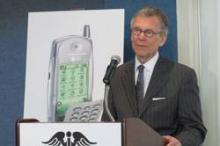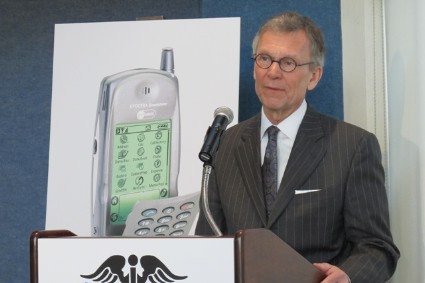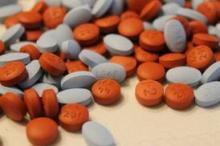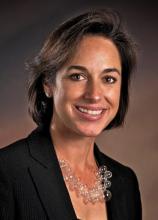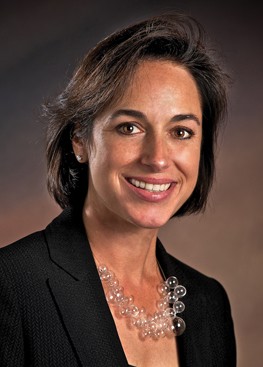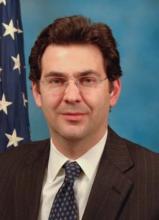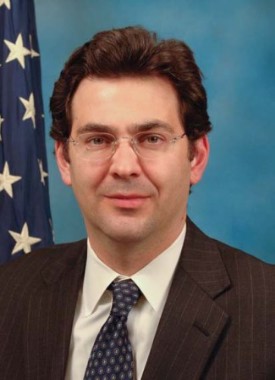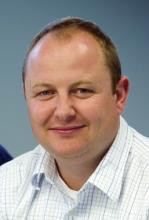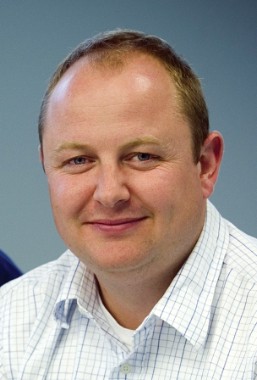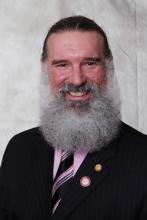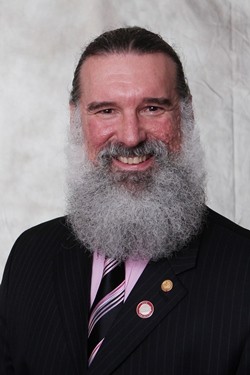User login
Alliance pushes Congress on payment for telemedicine
WASHINGTON – Medicare should cover telemedicine services regardless of geography, and physicians who use the technologies should be paid appropriately by all health insurers.
Those are among the goals of the Alliance for Connected Care, led by three formers leaders of the U.S. Senate.
At a press briefing, former Senate Majority Leader Tom Daschle (D-S.D.), former Senate Majority Leader Trent Lott (R-Miss.), and former Sen. John Breaux (R-La.) said that they have begun meeting with legislators regarding the coalition’s agenda.
Geographic expansion of telemedicine under Medicare is a key goal; the program currently will pay in rural areas only. Appropriate and widespread reimbursement for providers, including physicians, is another goal. The alliance also want to see telemedicine, remote patient monitoring and other technology that helps deliver and coordinate care, reimbursed under new models of care like patient-centered medical homes and accountable care organizations.
Sen. Lott said that he and Sen. Breaux recently met with Sen. Ron Wyden (D-Ore.), who likely will be the next chairman of the Finance Committee (since Chairman Max Baucus [D-Mont.] left Congress to become U.S. ambassador to China), as well as with committee member John Thune (R-S.D.).
"Both of them are very interested and committed," to helping increase access to telemedicine, Sen. Lott said at a briefing with reporters on Feb. 12.
Rep. Gregg Harper (R-Miss.) noted that his bill to encourage telemedicine is likely to see some action in the House this spring.
The Telehealth Enhancement Act of 2013 was introduced in October and currently has 14 cosponsors. With Congress looking at alternative delivery and payment models, "the time is right, the time is really now to grant providers flexibility to improve telemedicine," he said.
Telemedicine holds the potential to improve patient outcomes, quality of care, and to "meet the demands of the aging population," said Rep. Harper, who sits on the House Energy and Commerce Committee. It can also save Medicare and Medicaid money.
The Alliance for Connected Careis a nonprofit organization that includes a half-dozen large and small health-related companies on its board of directors: Verizon, Walgreens, CVS/Caremark, WellPoint, HealthSpot, and Teladoc. Associate members include Welch Allyn, Cardinal Health, Care Innovations, Doctor on Demand, and MDLive.
Those companies are mostly interested in selling telemedicine platforms to physicians or insurers. For 3 years, WellPoint has been offering its subscribers access to online consultations through LiveHealth Online. So far, it has saved money; patients have given it high marks, said John F. Jesser, vice president of provider engagement strategy at LiveHealth Online.
The alliance also plans to talk to state and federal officials about creating standard definitions for telemedicine, creating security and fraud protections, and making it easier for physicians to use telemedicine across state lines. According to the group, 20 states and the District of Columbia currently require commercial insurers to cover telemedicine services. Forty-five states allow Medicaid to pay for telemedicine.
Medicare is the laggard, Sen. Daschle said.
"We must ensure that our regulatory environment appropriately balances the exciting advances in technology for patients, while still maintaining safeguards that allow innovation," he said.
Several physician organizations and patient advocacy groups have signed on as advisers to the alliance, including the American Academy of Family Physicians, the National Association of ACOs, the American Heart Association, and National Alliance on Mental Illness.
On Twitter @aliciaault
WASHINGTON – Medicare should cover telemedicine services regardless of geography, and physicians who use the technologies should be paid appropriately by all health insurers.
Those are among the goals of the Alliance for Connected Care, led by three formers leaders of the U.S. Senate.
At a press briefing, former Senate Majority Leader Tom Daschle (D-S.D.), former Senate Majority Leader Trent Lott (R-Miss.), and former Sen. John Breaux (R-La.) said that they have begun meeting with legislators regarding the coalition’s agenda.
Geographic expansion of telemedicine under Medicare is a key goal; the program currently will pay in rural areas only. Appropriate and widespread reimbursement for providers, including physicians, is another goal. The alliance also want to see telemedicine, remote patient monitoring and other technology that helps deliver and coordinate care, reimbursed under new models of care like patient-centered medical homes and accountable care organizations.
Sen. Lott said that he and Sen. Breaux recently met with Sen. Ron Wyden (D-Ore.), who likely will be the next chairman of the Finance Committee (since Chairman Max Baucus [D-Mont.] left Congress to become U.S. ambassador to China), as well as with committee member John Thune (R-S.D.).
"Both of them are very interested and committed," to helping increase access to telemedicine, Sen. Lott said at a briefing with reporters on Feb. 12.
Rep. Gregg Harper (R-Miss.) noted that his bill to encourage telemedicine is likely to see some action in the House this spring.
The Telehealth Enhancement Act of 2013 was introduced in October and currently has 14 cosponsors. With Congress looking at alternative delivery and payment models, "the time is right, the time is really now to grant providers flexibility to improve telemedicine," he said.
Telemedicine holds the potential to improve patient outcomes, quality of care, and to "meet the demands of the aging population," said Rep. Harper, who sits on the House Energy and Commerce Committee. It can also save Medicare and Medicaid money.
The Alliance for Connected Careis a nonprofit organization that includes a half-dozen large and small health-related companies on its board of directors: Verizon, Walgreens, CVS/Caremark, WellPoint, HealthSpot, and Teladoc. Associate members include Welch Allyn, Cardinal Health, Care Innovations, Doctor on Demand, and MDLive.
Those companies are mostly interested in selling telemedicine platforms to physicians or insurers. For 3 years, WellPoint has been offering its subscribers access to online consultations through LiveHealth Online. So far, it has saved money; patients have given it high marks, said John F. Jesser, vice president of provider engagement strategy at LiveHealth Online.
The alliance also plans to talk to state and federal officials about creating standard definitions for telemedicine, creating security and fraud protections, and making it easier for physicians to use telemedicine across state lines. According to the group, 20 states and the District of Columbia currently require commercial insurers to cover telemedicine services. Forty-five states allow Medicaid to pay for telemedicine.
Medicare is the laggard, Sen. Daschle said.
"We must ensure that our regulatory environment appropriately balances the exciting advances in technology for patients, while still maintaining safeguards that allow innovation," he said.
Several physician organizations and patient advocacy groups have signed on as advisers to the alliance, including the American Academy of Family Physicians, the National Association of ACOs, the American Heart Association, and National Alliance on Mental Illness.
On Twitter @aliciaault
WASHINGTON – Medicare should cover telemedicine services regardless of geography, and physicians who use the technologies should be paid appropriately by all health insurers.
Those are among the goals of the Alliance for Connected Care, led by three formers leaders of the U.S. Senate.
At a press briefing, former Senate Majority Leader Tom Daschle (D-S.D.), former Senate Majority Leader Trent Lott (R-Miss.), and former Sen. John Breaux (R-La.) said that they have begun meeting with legislators regarding the coalition’s agenda.
Geographic expansion of telemedicine under Medicare is a key goal; the program currently will pay in rural areas only. Appropriate and widespread reimbursement for providers, including physicians, is another goal. The alliance also want to see telemedicine, remote patient monitoring and other technology that helps deliver and coordinate care, reimbursed under new models of care like patient-centered medical homes and accountable care organizations.
Sen. Lott said that he and Sen. Breaux recently met with Sen. Ron Wyden (D-Ore.), who likely will be the next chairman of the Finance Committee (since Chairman Max Baucus [D-Mont.] left Congress to become U.S. ambassador to China), as well as with committee member John Thune (R-S.D.).
"Both of them are very interested and committed," to helping increase access to telemedicine, Sen. Lott said at a briefing with reporters on Feb. 12.
Rep. Gregg Harper (R-Miss.) noted that his bill to encourage telemedicine is likely to see some action in the House this spring.
The Telehealth Enhancement Act of 2013 was introduced in October and currently has 14 cosponsors. With Congress looking at alternative delivery and payment models, "the time is right, the time is really now to grant providers flexibility to improve telemedicine," he said.
Telemedicine holds the potential to improve patient outcomes, quality of care, and to "meet the demands of the aging population," said Rep. Harper, who sits on the House Energy and Commerce Committee. It can also save Medicare and Medicaid money.
The Alliance for Connected Careis a nonprofit organization that includes a half-dozen large and small health-related companies on its board of directors: Verizon, Walgreens, CVS/Caremark, WellPoint, HealthSpot, and Teladoc. Associate members include Welch Allyn, Cardinal Health, Care Innovations, Doctor on Demand, and MDLive.
Those companies are mostly interested in selling telemedicine platforms to physicians or insurers. For 3 years, WellPoint has been offering its subscribers access to online consultations through LiveHealth Online. So far, it has saved money; patients have given it high marks, said John F. Jesser, vice president of provider engagement strategy at LiveHealth Online.
The alliance also plans to talk to state and federal officials about creating standard definitions for telemedicine, creating security and fraud protections, and making it easier for physicians to use telemedicine across state lines. According to the group, 20 states and the District of Columbia currently require commercial insurers to cover telemedicine services. Forty-five states allow Medicaid to pay for telemedicine.
Medicare is the laggard, Sen. Daschle said.
"We must ensure that our regulatory environment appropriately balances the exciting advances in technology for patients, while still maintaining safeguards that allow innovation," he said.
Several physician organizations and patient advocacy groups have signed on as advisers to the alliance, including the American Academy of Family Physicians, the National Association of ACOs, the American Heart Association, and National Alliance on Mental Illness.
On Twitter @aliciaault
2014 budget: Less $ for ACA, IPAB
A $1 trillion spending bill that funds the government through Sept. 30 restores money for some health programs but delivers a blow to the Affordable Care Act.
Even so, President Obama is expected to sign it.
The House approved the Consolidated Appropriations Act for FY 2014 (H.R. 3547) on Jan. 15 by a vote of 359-67, and the Senate approved it a day later 72-26.
Republican members of the House Appropriations Committee added language to the bill that puts a hold on any new funding for the ACA in fiscal 2014 and takes $1 billion out of the law’s Prevention and Public Health Fund. The fund is hotly contested and has been labeled a "slush fund," by opponents.
The House Appropriations panel also succeeded in cutting $10 million in funding for the Independent Payment Advisory Board (IPAB). The IPAB was due to make its first recommendations by mid-January; however, the Obama administration has yet to appoint any members to the Board.
The spending bill continues to ban the use federal funds for needle exchanges; for research that creates or uses embryos; and for abortion, except in the case of rape, incest, or endangerment of the life of the mother.
The bill includes a $3.7 billion budget for the Centers for Medicare and Medicaid Services – almost $200 million less than it received in fiscal year 2013 but equal to what it would receive under sequestration. Some $305 million is earmarked for the timely processing and payment of benefits.
The bill increases funding for other federal health-related agencies. The National Institutes of Health budget was increased $1 billion, which should allow it to begin 385 clinical trials, according to the Senate Appropriations Committee.
There is new funding for the Brain Research Through Advancing of Innovative Neurotechnologies (BRAIN) Initiative, and funding for an initiative to study prevention and treatments for Alzheimer’s disease.
Mental health programs at various labor, health, and education agencies will receive $1.13 billion, an increase of $213 million, according to the Senate panel. Those programs include violence prevention and grants to schools to help train teachers and to help build a mental health workforce.
The Senate Committee estimates that new training will help add 4,375 social workers, psychologists, therapists and other mental health professionals to the behavioral health workforce. The Substance Abuse and Mental Health Services Administration received a $144 million increase in its budget, bringing it to $3.6 billion.
Funding for the Centers for Disease Control and Prevention was increased $567 million to $6.9 billion. That budget includes $30 million to support the Advanced Molecular Detection initiative, which helps the agency detect and stop infectious disease outbreaks and $160 million for the Preventive Health & Health Services Block Grant.
The legislation also includes $3.6 billion to improve the quantity and quality of health care services in medically underserved areas and populations. As part of that, $350 million is appropriated to create more than 450 new community health centers and expand services at existing ones.
A $1 trillion spending bill that funds the government through Sept. 30 restores money for some health programs but delivers a blow to the Affordable Care Act.
Even so, President Obama is expected to sign it.
The House approved the Consolidated Appropriations Act for FY 2014 (H.R. 3547) on Jan. 15 by a vote of 359-67, and the Senate approved it a day later 72-26.
Republican members of the House Appropriations Committee added language to the bill that puts a hold on any new funding for the ACA in fiscal 2014 and takes $1 billion out of the law’s Prevention and Public Health Fund. The fund is hotly contested and has been labeled a "slush fund," by opponents.
The House Appropriations panel also succeeded in cutting $10 million in funding for the Independent Payment Advisory Board (IPAB). The IPAB was due to make its first recommendations by mid-January; however, the Obama administration has yet to appoint any members to the Board.
The spending bill continues to ban the use federal funds for needle exchanges; for research that creates or uses embryos; and for abortion, except in the case of rape, incest, or endangerment of the life of the mother.
The bill includes a $3.7 billion budget for the Centers for Medicare and Medicaid Services – almost $200 million less than it received in fiscal year 2013 but equal to what it would receive under sequestration. Some $305 million is earmarked for the timely processing and payment of benefits.
The bill increases funding for other federal health-related agencies. The National Institutes of Health budget was increased $1 billion, which should allow it to begin 385 clinical trials, according to the Senate Appropriations Committee.
There is new funding for the Brain Research Through Advancing of Innovative Neurotechnologies (BRAIN) Initiative, and funding for an initiative to study prevention and treatments for Alzheimer’s disease.
Mental health programs at various labor, health, and education agencies will receive $1.13 billion, an increase of $213 million, according to the Senate panel. Those programs include violence prevention and grants to schools to help train teachers and to help build a mental health workforce.
The Senate Committee estimates that new training will help add 4,375 social workers, psychologists, therapists and other mental health professionals to the behavioral health workforce. The Substance Abuse and Mental Health Services Administration received a $144 million increase in its budget, bringing it to $3.6 billion.
Funding for the Centers for Disease Control and Prevention was increased $567 million to $6.9 billion. That budget includes $30 million to support the Advanced Molecular Detection initiative, which helps the agency detect and stop infectious disease outbreaks and $160 million for the Preventive Health & Health Services Block Grant.
The legislation also includes $3.6 billion to improve the quantity and quality of health care services in medically underserved areas and populations. As part of that, $350 million is appropriated to create more than 450 new community health centers and expand services at existing ones.
A $1 trillion spending bill that funds the government through Sept. 30 restores money for some health programs but delivers a blow to the Affordable Care Act.
Even so, President Obama is expected to sign it.
The House approved the Consolidated Appropriations Act for FY 2014 (H.R. 3547) on Jan. 15 by a vote of 359-67, and the Senate approved it a day later 72-26.
Republican members of the House Appropriations Committee added language to the bill that puts a hold on any new funding for the ACA in fiscal 2014 and takes $1 billion out of the law’s Prevention and Public Health Fund. The fund is hotly contested and has been labeled a "slush fund," by opponents.
The House Appropriations panel also succeeded in cutting $10 million in funding for the Independent Payment Advisory Board (IPAB). The IPAB was due to make its first recommendations by mid-January; however, the Obama administration has yet to appoint any members to the Board.
The spending bill continues to ban the use federal funds for needle exchanges; for research that creates or uses embryos; and for abortion, except in the case of rape, incest, or endangerment of the life of the mother.
The bill includes a $3.7 billion budget for the Centers for Medicare and Medicaid Services – almost $200 million less than it received in fiscal year 2013 but equal to what it would receive under sequestration. Some $305 million is earmarked for the timely processing and payment of benefits.
The bill increases funding for other federal health-related agencies. The National Institutes of Health budget was increased $1 billion, which should allow it to begin 385 clinical trials, according to the Senate Appropriations Committee.
There is new funding for the Brain Research Through Advancing of Innovative Neurotechnologies (BRAIN) Initiative, and funding for an initiative to study prevention and treatments for Alzheimer’s disease.
Mental health programs at various labor, health, and education agencies will receive $1.13 billion, an increase of $213 million, according to the Senate panel. Those programs include violence prevention and grants to schools to help train teachers and to help build a mental health workforce.
The Senate Committee estimates that new training will help add 4,375 social workers, psychologists, therapists and other mental health professionals to the behavioral health workforce. The Substance Abuse and Mental Health Services Administration received a $144 million increase in its budget, bringing it to $3.6 billion.
Funding for the Centers for Disease Control and Prevention was increased $567 million to $6.9 billion. That budget includes $30 million to support the Advanced Molecular Detection initiative, which helps the agency detect and stop infectious disease outbreaks and $160 million for the Preventive Health & Health Services Block Grant.
The legislation also includes $3.6 billion to improve the quantity and quality of health care services in medically underserved areas and populations. As part of that, $350 million is appropriated to create more than 450 new community health centers and expand services at existing ones.
No new cardiovascular warnings needed for NSAIDs say FDA advisers
SILVER SPRING, MD. – There do not need to be major changes to the warning labels on prescription and over-the-counter nonsteroidal anti-inflammatory medications, said a group of federal advisers on Feb. 12.
The members of the Arthritis Advisory Committee and the Drug Safety and Risk Management Advisory Committee said that the evidence that had been presented to them over the 2-day meeting about potentially new cardiovascular (CV) risks with drugs in the class was not sufficient to change labeling.
And, in a 16-9 vote, they said there were not enough data to suggest that naproxen presented a substantially lower risk of CV events than did either ibuprofen or selective NSAIDs, such as cyclooxygenase-2 inhibitors.
But some panelists said that even without a label change, the evidence on naproxen – which showed a trend toward a better safety profile – would probably sway them to prescribe or recommend it more often, especially in patients at risk for CV side effects. "The preponderance of evidence pushes me to the conclusion that I’m personally switching to naproxen and I’ll be pushing my patients to it," said Dr. Peter Kaboli, an internist at the Iowa City Veterans Affairs Medical Center and a member of the drug safety advisory panel.
There was a particular concern for patients with rheumatic diseases, who are considered to be at higher risk for CV events. Dr. Robert Lahita, an arthritis committee member and a professor of medicine at Rutgers Biomedical and Health Sciences, Newark, N.J., said that his rheumatoid patients "take NSAIDs like candy," and rarely follow his directions for dose or duration. "How do we address that?" he asked.
Dr. Irwin J. Russell, a fibromyalgia researcher at the Arthritis and Osteoporosis Center of South Texas, San Antonio, said that the data on NSAIDs should prompt inquiries into whether the elevated cardiovascular disease risk in rheumatic patients might be linked to their chronic use of the medications.
To get more answers on NSAID safety, the FDA advisers urged the agency to allow the PRECISION (Prospective Randomized Evaluation of Celecoxib Integrated Safety vs. Ibuprofen or Naproxen) trial to continue. That study, sponsored by Pfizer, began in the wake of a joint meeting of the same panels in 2005. It is directed by an independent academic committee and is expected to be completed by late 2015.
In June 2005, the FDA required all prescription NSAIDs to have a boxed warning on the potential for serious adverse CV events. NSAIDs also carry a warning on the potential for gastrointestinal adverse events. A Medication Guide was developed for patients to inform them of the risk of CV events and gastrointestinal bleeding with all NSAIDs.
The latest panel meeting was held because "9 years later, there are more data available and questions still remain," said Dr. John Jenkins, director of the FDA’s Center for Drug Evaluation and Research. That new data primarily came from a study authored by the Coxib and traditional NSAID Trialists’ Collaboration at Oxford (England) University (Lancet 2013:382;769-79). Most of the FDA advisers said that the data from that study were less than satisfactory, in part because they mashed together trials of different NSAIDs taken at different dosage levels.
The committee did say that it would like to see clearer warnings on over-the-counter (OTC) NSAIDs, especially emphasizing that patients should take the lowest possible dose for the shortest period of time. "Many patients are taking above what the OTC label" recommends, said Dr. Tuhina Neogi, chair of the joint committees and a rheumatologist at Boston University.
Some data presented at the meeting suggested that patients have many areas of misunderstanding when it comes to OTC NSAIDs. Dr. Byron Cryer, chairman of the Alliance for Rational Use of NSAIDs, said that a recent survey conducted by his nonprofit group found that less than half of those taking an OTC formulation said they pay attention to potential interactions or side effects. Thirty-six percent were not sure what an NSAID was, and 18% said they’d used OTC and prescription NSAIDs concomitantly.
The FDA usually follows the advice of its advisory panels.
On Twitter @aliciaault
SILVER SPRING, MD. – There do not need to be major changes to the warning labels on prescription and over-the-counter nonsteroidal anti-inflammatory medications, said a group of federal advisers on Feb. 12.
The members of the Arthritis Advisory Committee and the Drug Safety and Risk Management Advisory Committee said that the evidence that had been presented to them over the 2-day meeting about potentially new cardiovascular (CV) risks with drugs in the class was not sufficient to change labeling.
And, in a 16-9 vote, they said there were not enough data to suggest that naproxen presented a substantially lower risk of CV events than did either ibuprofen or selective NSAIDs, such as cyclooxygenase-2 inhibitors.
But some panelists said that even without a label change, the evidence on naproxen – which showed a trend toward a better safety profile – would probably sway them to prescribe or recommend it more often, especially in patients at risk for CV side effects. "The preponderance of evidence pushes me to the conclusion that I’m personally switching to naproxen and I’ll be pushing my patients to it," said Dr. Peter Kaboli, an internist at the Iowa City Veterans Affairs Medical Center and a member of the drug safety advisory panel.
There was a particular concern for patients with rheumatic diseases, who are considered to be at higher risk for CV events. Dr. Robert Lahita, an arthritis committee member and a professor of medicine at Rutgers Biomedical and Health Sciences, Newark, N.J., said that his rheumatoid patients "take NSAIDs like candy," and rarely follow his directions for dose or duration. "How do we address that?" he asked.
Dr. Irwin J. Russell, a fibromyalgia researcher at the Arthritis and Osteoporosis Center of South Texas, San Antonio, said that the data on NSAIDs should prompt inquiries into whether the elevated cardiovascular disease risk in rheumatic patients might be linked to their chronic use of the medications.
To get more answers on NSAID safety, the FDA advisers urged the agency to allow the PRECISION (Prospective Randomized Evaluation of Celecoxib Integrated Safety vs. Ibuprofen or Naproxen) trial to continue. That study, sponsored by Pfizer, began in the wake of a joint meeting of the same panels in 2005. It is directed by an independent academic committee and is expected to be completed by late 2015.
In June 2005, the FDA required all prescription NSAIDs to have a boxed warning on the potential for serious adverse CV events. NSAIDs also carry a warning on the potential for gastrointestinal adverse events. A Medication Guide was developed for patients to inform them of the risk of CV events and gastrointestinal bleeding with all NSAIDs.
The latest panel meeting was held because "9 years later, there are more data available and questions still remain," said Dr. John Jenkins, director of the FDA’s Center for Drug Evaluation and Research. That new data primarily came from a study authored by the Coxib and traditional NSAID Trialists’ Collaboration at Oxford (England) University (Lancet 2013:382;769-79). Most of the FDA advisers said that the data from that study were less than satisfactory, in part because they mashed together trials of different NSAIDs taken at different dosage levels.
The committee did say that it would like to see clearer warnings on over-the-counter (OTC) NSAIDs, especially emphasizing that patients should take the lowest possible dose for the shortest period of time. "Many patients are taking above what the OTC label" recommends, said Dr. Tuhina Neogi, chair of the joint committees and a rheumatologist at Boston University.
Some data presented at the meeting suggested that patients have many areas of misunderstanding when it comes to OTC NSAIDs. Dr. Byron Cryer, chairman of the Alliance for Rational Use of NSAIDs, said that a recent survey conducted by his nonprofit group found that less than half of those taking an OTC formulation said they pay attention to potential interactions or side effects. Thirty-six percent were not sure what an NSAID was, and 18% said they’d used OTC and prescription NSAIDs concomitantly.
The FDA usually follows the advice of its advisory panels.
On Twitter @aliciaault
SILVER SPRING, MD. – There do not need to be major changes to the warning labels on prescription and over-the-counter nonsteroidal anti-inflammatory medications, said a group of federal advisers on Feb. 12.
The members of the Arthritis Advisory Committee and the Drug Safety and Risk Management Advisory Committee said that the evidence that had been presented to them over the 2-day meeting about potentially new cardiovascular (CV) risks with drugs in the class was not sufficient to change labeling.
And, in a 16-9 vote, they said there were not enough data to suggest that naproxen presented a substantially lower risk of CV events than did either ibuprofen or selective NSAIDs, such as cyclooxygenase-2 inhibitors.
But some panelists said that even without a label change, the evidence on naproxen – which showed a trend toward a better safety profile – would probably sway them to prescribe or recommend it more often, especially in patients at risk for CV side effects. "The preponderance of evidence pushes me to the conclusion that I’m personally switching to naproxen and I’ll be pushing my patients to it," said Dr. Peter Kaboli, an internist at the Iowa City Veterans Affairs Medical Center and a member of the drug safety advisory panel.
There was a particular concern for patients with rheumatic diseases, who are considered to be at higher risk for CV events. Dr. Robert Lahita, an arthritis committee member and a professor of medicine at Rutgers Biomedical and Health Sciences, Newark, N.J., said that his rheumatoid patients "take NSAIDs like candy," and rarely follow his directions for dose or duration. "How do we address that?" he asked.
Dr. Irwin J. Russell, a fibromyalgia researcher at the Arthritis and Osteoporosis Center of South Texas, San Antonio, said that the data on NSAIDs should prompt inquiries into whether the elevated cardiovascular disease risk in rheumatic patients might be linked to their chronic use of the medications.
To get more answers on NSAID safety, the FDA advisers urged the agency to allow the PRECISION (Prospective Randomized Evaluation of Celecoxib Integrated Safety vs. Ibuprofen or Naproxen) trial to continue. That study, sponsored by Pfizer, began in the wake of a joint meeting of the same panels in 2005. It is directed by an independent academic committee and is expected to be completed by late 2015.
In June 2005, the FDA required all prescription NSAIDs to have a boxed warning on the potential for serious adverse CV events. NSAIDs also carry a warning on the potential for gastrointestinal adverse events. A Medication Guide was developed for patients to inform them of the risk of CV events and gastrointestinal bleeding with all NSAIDs.
The latest panel meeting was held because "9 years later, there are more data available and questions still remain," said Dr. John Jenkins, director of the FDA’s Center for Drug Evaluation and Research. That new data primarily came from a study authored by the Coxib and traditional NSAID Trialists’ Collaboration at Oxford (England) University (Lancet 2013:382;769-79). Most of the FDA advisers said that the data from that study were less than satisfactory, in part because they mashed together trials of different NSAIDs taken at different dosage levels.
The committee did say that it would like to see clearer warnings on over-the-counter (OTC) NSAIDs, especially emphasizing that patients should take the lowest possible dose for the shortest period of time. "Many patients are taking above what the OTC label" recommends, said Dr. Tuhina Neogi, chair of the joint committees and a rheumatologist at Boston University.
Some data presented at the meeting suggested that patients have many areas of misunderstanding when it comes to OTC NSAIDs. Dr. Byron Cryer, chairman of the Alliance for Rational Use of NSAIDs, said that a recent survey conducted by his nonprofit group found that less than half of those taking an OTC formulation said they pay attention to potential interactions or side effects. Thirty-six percent were not sure what an NSAID was, and 18% said they’d used OTC and prescription NSAIDs concomitantly.
The FDA usually follows the advice of its advisory panels.
On Twitter @aliciaault
AT AN FDA ADVISORY COMMITTEE MEETING
NSAID makers argue against new warnings on CV risks
SILVER SPRING, MD. – Manufacturers of prescription and over-the-counter nonsteroidal anti-inflammatory medications said at a joint meeting of two Food and Drug Administration advisory committees that there is not enough evidence to increase warnings about potential risk for cardiovascular events.
Not surprisingly, Pfizer, Novartis, and Johnson & Johnson’s McNeil Consumer Healthcare division all argued that there are also not enough data to suggest that Bayer’s naproxen has any less risk of CV events than other NSAIDs – as has been suggested by many studies.
The FDA’s Arthritis Advisory Committee (AAC) and the Drug Safety and Risk Management Advisory Committee are due to vote on Feb. 11 on whether there should be more warnings for prescription and over-the-counter (OTC) versions of NSAIDs on the potential for cardiovascular events, especially in patients at higher risk for heart attack, heart failure, or stroke. They also are being asked to consider if the risk changes with duration of treatment and whether naproxen might be safer than other NSAIDs. Finally, the panels are being asked to assess whether an ongoing study of NSAID safety – Pfizer’s PRECISION (Prospective Randomized Evaluation of Celecoxib Integrated Safety vs. Ibuprofen or Naproxen) – should continue.
The new review of NSAID safety was prompted in large part by a meta-analysis from the Coxib and traditional NSAID Trialists’ (CNT) Collaboration at Oxford University. The meta-analysis assessed both the gastrointestinal and cardiovascular risks of nonselective NSAIDs. It concluded that naproxen had a lower risk of CV thromboembolic events than celecoxib and ibuprofen (Lancet 2013;382:769-79).
The stakes are high. According to the FDA and manufacturers who spoke at the advisory committee meeting on Feb. 10, there are some 100 million prescriptions written for NSAIDs each year, and 29 million Americans are regular users of NSAIDs.
The Oxford meta-analysis honed in on 639 trials that involved a selective NSAID (collectively known as coxibs) and nonselective NSAIDs, including naproxen, diclofenac, and ibuprofen, Dr. Colin Baigent, professor of epidemiology at the University of Oxford (England), told the panelists. For coxibs, there was a 37% increase in cardiovascular events, mostly from myocardial infarction or coronary heart disease. There also was a 37% increase in major vascular events but no evidence of increased stroke risk. Naproxen had a better safety profile, but "we can’t say there is no risk," Dr. Baigent said. There was a doubling of risk for heart failure with all NSAIDs.
Analyses of various registries in Denmark reached similar conclusions, said Dr. Gunnar H. Gislason, professor of cardiology at the University of Copenhagen’s Hospital Gentofte. There was an increased risk of cardiovascular events and death, and the risk increased with higher doses with most NSAIDs, he noted.
The risk began with starting doses and persisted, but naproxen had a much lower risk. Even so, Dr. Gislason said he believed that "use of NSAIDs should be limited, especially among high-risk individuals and patients with established cardiovascular disease." He also recommended avoiding diclofenac and cyclooxygenase-2 (COX-2) inhibitors, which had the highest risk in the Danish studies.
Pfizer, which has seven NSAIDs approved in the United States, said that the Oxford analysis did not provide sufficient evidence for strengthening or changing current class-wide warnings about cardiovascular events. The trial relied on indirect comparisons and studies of products like diclofenac that are not widely used in the United States, said Dr. Milton L. Pressler, Pfizer’s vice president for clinical sciences.
Novartis, which makes diclofenac, also said that the evidence was not sufficient to make any major changes. The company, however, did propose in October to strengthen warnings for diclofenac that would caution against using more than 150 mg daily or using it for longer than 4 weeks in patients at high risk for CV events.
Naproxen may be safer in part because it acts more like aspirin, inhibiting platelet aggregation, and thus is less likely to trigger thrombotic events, said Irene Laurora, Pharm.D., vice president of medical affairs at Bayer Healthcare, which makes Aleve, the OTC formulation of naproxen. The product should be labeled as having less potential for causing CV events, said Leonard Baum, vice president of regulatory affairs for Bayer.
Labeling for OTC products is sufficient to warn consumers about the dangers of high doses or longer use, said Dr. Ed Kuffner, McNeil’s vice president of medical affairs and clinical research. McNeil makes the OTC ibuprofen product Motrin. He also noted that current labels also urge higher-risk patients, such as those with hypertension or underlying heart disease, to consult a physician before using ibuprofen.
Many of the panelists were interested in learning more about the PRECISION trial. Principal investigator Steven E. Nissen said that the study is 95% enrolled, with 22,621 patients randomized at 486 sites. Dr. Nissen, chair of cardiovascular medicine at the Cleveland Clinic, said PRECISION offers a real-world trial that, when completed in late 2015, will answer many outstanding questions. The study is still blinded, but Dr. Nissen said that several analyses are completed, including an ambulatory blood pressure substudy, a comparative renal safety analysis, a comparative gastrointestinal safety analysis, and comparative effects on symptoms and quality of life.
The data monitoring committee issued a statement to the FDA panels that "the remaining events to be captured during the next 18-to-24-months could have a very substantive impact on the interpretability and reliability of trial results."
Dr. Nissen argued that the study should not be stopped. It is being funded by Pfizer, but the study is being guided by an executive committee that is fully independent and unpaid, he said, adding that the data safety monitoring committee is also independent of Pfizer.
On Twitter @aliciaault
SILVER SPRING, MD. – Manufacturers of prescription and over-the-counter nonsteroidal anti-inflammatory medications said at a joint meeting of two Food and Drug Administration advisory committees that there is not enough evidence to increase warnings about potential risk for cardiovascular events.
Not surprisingly, Pfizer, Novartis, and Johnson & Johnson’s McNeil Consumer Healthcare division all argued that there are also not enough data to suggest that Bayer’s naproxen has any less risk of CV events than other NSAIDs – as has been suggested by many studies.
The FDA’s Arthritis Advisory Committee (AAC) and the Drug Safety and Risk Management Advisory Committee are due to vote on Feb. 11 on whether there should be more warnings for prescription and over-the-counter (OTC) versions of NSAIDs on the potential for cardiovascular events, especially in patients at higher risk for heart attack, heart failure, or stroke. They also are being asked to consider if the risk changes with duration of treatment and whether naproxen might be safer than other NSAIDs. Finally, the panels are being asked to assess whether an ongoing study of NSAID safety – Pfizer’s PRECISION (Prospective Randomized Evaluation of Celecoxib Integrated Safety vs. Ibuprofen or Naproxen) – should continue.
The new review of NSAID safety was prompted in large part by a meta-analysis from the Coxib and traditional NSAID Trialists’ (CNT) Collaboration at Oxford University. The meta-analysis assessed both the gastrointestinal and cardiovascular risks of nonselective NSAIDs. It concluded that naproxen had a lower risk of CV thromboembolic events than celecoxib and ibuprofen (Lancet 2013;382:769-79).
The stakes are high. According to the FDA and manufacturers who spoke at the advisory committee meeting on Feb. 10, there are some 100 million prescriptions written for NSAIDs each year, and 29 million Americans are regular users of NSAIDs.
The Oxford meta-analysis honed in on 639 trials that involved a selective NSAID (collectively known as coxibs) and nonselective NSAIDs, including naproxen, diclofenac, and ibuprofen, Dr. Colin Baigent, professor of epidemiology at the University of Oxford (England), told the panelists. For coxibs, there was a 37% increase in cardiovascular events, mostly from myocardial infarction or coronary heart disease. There also was a 37% increase in major vascular events but no evidence of increased stroke risk. Naproxen had a better safety profile, but "we can’t say there is no risk," Dr. Baigent said. There was a doubling of risk for heart failure with all NSAIDs.
Analyses of various registries in Denmark reached similar conclusions, said Dr. Gunnar H. Gislason, professor of cardiology at the University of Copenhagen’s Hospital Gentofte. There was an increased risk of cardiovascular events and death, and the risk increased with higher doses with most NSAIDs, he noted.
The risk began with starting doses and persisted, but naproxen had a much lower risk. Even so, Dr. Gislason said he believed that "use of NSAIDs should be limited, especially among high-risk individuals and patients with established cardiovascular disease." He also recommended avoiding diclofenac and cyclooxygenase-2 (COX-2) inhibitors, which had the highest risk in the Danish studies.
Pfizer, which has seven NSAIDs approved in the United States, said that the Oxford analysis did not provide sufficient evidence for strengthening or changing current class-wide warnings about cardiovascular events. The trial relied on indirect comparisons and studies of products like diclofenac that are not widely used in the United States, said Dr. Milton L. Pressler, Pfizer’s vice president for clinical sciences.
Novartis, which makes diclofenac, also said that the evidence was not sufficient to make any major changes. The company, however, did propose in October to strengthen warnings for diclofenac that would caution against using more than 150 mg daily or using it for longer than 4 weeks in patients at high risk for CV events.
Naproxen may be safer in part because it acts more like aspirin, inhibiting platelet aggregation, and thus is less likely to trigger thrombotic events, said Irene Laurora, Pharm.D., vice president of medical affairs at Bayer Healthcare, which makes Aleve, the OTC formulation of naproxen. The product should be labeled as having less potential for causing CV events, said Leonard Baum, vice president of regulatory affairs for Bayer.
Labeling for OTC products is sufficient to warn consumers about the dangers of high doses or longer use, said Dr. Ed Kuffner, McNeil’s vice president of medical affairs and clinical research. McNeil makes the OTC ibuprofen product Motrin. He also noted that current labels also urge higher-risk patients, such as those with hypertension or underlying heart disease, to consult a physician before using ibuprofen.
Many of the panelists were interested in learning more about the PRECISION trial. Principal investigator Steven E. Nissen said that the study is 95% enrolled, with 22,621 patients randomized at 486 sites. Dr. Nissen, chair of cardiovascular medicine at the Cleveland Clinic, said PRECISION offers a real-world trial that, when completed in late 2015, will answer many outstanding questions. The study is still blinded, but Dr. Nissen said that several analyses are completed, including an ambulatory blood pressure substudy, a comparative renal safety analysis, a comparative gastrointestinal safety analysis, and comparative effects on symptoms and quality of life.
The data monitoring committee issued a statement to the FDA panels that "the remaining events to be captured during the next 18-to-24-months could have a very substantive impact on the interpretability and reliability of trial results."
Dr. Nissen argued that the study should not be stopped. It is being funded by Pfizer, but the study is being guided by an executive committee that is fully independent and unpaid, he said, adding that the data safety monitoring committee is also independent of Pfizer.
On Twitter @aliciaault
SILVER SPRING, MD. – Manufacturers of prescription and over-the-counter nonsteroidal anti-inflammatory medications said at a joint meeting of two Food and Drug Administration advisory committees that there is not enough evidence to increase warnings about potential risk for cardiovascular events.
Not surprisingly, Pfizer, Novartis, and Johnson & Johnson’s McNeil Consumer Healthcare division all argued that there are also not enough data to suggest that Bayer’s naproxen has any less risk of CV events than other NSAIDs – as has been suggested by many studies.
The FDA’s Arthritis Advisory Committee (AAC) and the Drug Safety and Risk Management Advisory Committee are due to vote on Feb. 11 on whether there should be more warnings for prescription and over-the-counter (OTC) versions of NSAIDs on the potential for cardiovascular events, especially in patients at higher risk for heart attack, heart failure, or stroke. They also are being asked to consider if the risk changes with duration of treatment and whether naproxen might be safer than other NSAIDs. Finally, the panels are being asked to assess whether an ongoing study of NSAID safety – Pfizer’s PRECISION (Prospective Randomized Evaluation of Celecoxib Integrated Safety vs. Ibuprofen or Naproxen) – should continue.
The new review of NSAID safety was prompted in large part by a meta-analysis from the Coxib and traditional NSAID Trialists’ (CNT) Collaboration at Oxford University. The meta-analysis assessed both the gastrointestinal and cardiovascular risks of nonselective NSAIDs. It concluded that naproxen had a lower risk of CV thromboembolic events than celecoxib and ibuprofen (Lancet 2013;382:769-79).
The stakes are high. According to the FDA and manufacturers who spoke at the advisory committee meeting on Feb. 10, there are some 100 million prescriptions written for NSAIDs each year, and 29 million Americans are regular users of NSAIDs.
The Oxford meta-analysis honed in on 639 trials that involved a selective NSAID (collectively known as coxibs) and nonselective NSAIDs, including naproxen, diclofenac, and ibuprofen, Dr. Colin Baigent, professor of epidemiology at the University of Oxford (England), told the panelists. For coxibs, there was a 37% increase in cardiovascular events, mostly from myocardial infarction or coronary heart disease. There also was a 37% increase in major vascular events but no evidence of increased stroke risk. Naproxen had a better safety profile, but "we can’t say there is no risk," Dr. Baigent said. There was a doubling of risk for heart failure with all NSAIDs.
Analyses of various registries in Denmark reached similar conclusions, said Dr. Gunnar H. Gislason, professor of cardiology at the University of Copenhagen’s Hospital Gentofte. There was an increased risk of cardiovascular events and death, and the risk increased with higher doses with most NSAIDs, he noted.
The risk began with starting doses and persisted, but naproxen had a much lower risk. Even so, Dr. Gislason said he believed that "use of NSAIDs should be limited, especially among high-risk individuals and patients with established cardiovascular disease." He also recommended avoiding diclofenac and cyclooxygenase-2 (COX-2) inhibitors, which had the highest risk in the Danish studies.
Pfizer, which has seven NSAIDs approved in the United States, said that the Oxford analysis did not provide sufficient evidence for strengthening or changing current class-wide warnings about cardiovascular events. The trial relied on indirect comparisons and studies of products like diclofenac that are not widely used in the United States, said Dr. Milton L. Pressler, Pfizer’s vice president for clinical sciences.
Novartis, which makes diclofenac, also said that the evidence was not sufficient to make any major changes. The company, however, did propose in October to strengthen warnings for diclofenac that would caution against using more than 150 mg daily or using it for longer than 4 weeks in patients at high risk for CV events.
Naproxen may be safer in part because it acts more like aspirin, inhibiting platelet aggregation, and thus is less likely to trigger thrombotic events, said Irene Laurora, Pharm.D., vice president of medical affairs at Bayer Healthcare, which makes Aleve, the OTC formulation of naproxen. The product should be labeled as having less potential for causing CV events, said Leonard Baum, vice president of regulatory affairs for Bayer.
Labeling for OTC products is sufficient to warn consumers about the dangers of high doses or longer use, said Dr. Ed Kuffner, McNeil’s vice president of medical affairs and clinical research. McNeil makes the OTC ibuprofen product Motrin. He also noted that current labels also urge higher-risk patients, such as those with hypertension or underlying heart disease, to consult a physician before using ibuprofen.
Many of the panelists were interested in learning more about the PRECISION trial. Principal investigator Steven E. Nissen said that the study is 95% enrolled, with 22,621 patients randomized at 486 sites. Dr. Nissen, chair of cardiovascular medicine at the Cleveland Clinic, said PRECISION offers a real-world trial that, when completed in late 2015, will answer many outstanding questions. The study is still blinded, but Dr. Nissen said that several analyses are completed, including an ambulatory blood pressure substudy, a comparative renal safety analysis, a comparative gastrointestinal safety analysis, and comparative effects on symptoms and quality of life.
The data monitoring committee issued a statement to the FDA panels that "the remaining events to be captured during the next 18-to-24-months could have a very substantive impact on the interpretability and reliability of trial results."
Dr. Nissen argued that the study should not be stopped. It is being funded by Pfizer, but the study is being guided by an executive committee that is fully independent and unpaid, he said, adding that the data safety monitoring committee is also independent of Pfizer.
On Twitter @aliciaault
AT AN FDA ADVISORY COMMITTEE MEETING
SGR replacement promises small pay boost over 5 years
Doctors could see a 0.5% pay increase for 5 years and a transition to alternative delivery and payment models under consensus legislation to repeal the Medicare Sustainable Growth Rate formula.
The legislation, the SGR Repeal and Medicare Provider Payment Modernization Act of 2014 (H.R. 4015), is based on three separate proposals approved last year by the House Energy and Commerce Committee, the House Ways and Means Committee, and the Senate Finance Committee. It was introduced Feb. 6.
The bill does not address how to pay for the SGR replacement. One recent estimate by the Congressional Budget Office put that price tag at $120 billion to $150 billion.
Sen. Max Baucus (D-Mont.), chairman of the Finance committee, hailed the agreement. "This proposal would bring that cycle to an end and fix the broken system," he said in a statement. "Our bill makes Medicare’s physician payments more modern and efficient, and it will protect seniors’ access to their doctors."
American Medical Association President Ardis Dee Hoven commented that this consensus bill means that "Congress is closer than it has ever been to enacting fiscally-prudent legislation that would repeal Medicare’s fatally flawed sustainable growth rate formula."
Dr. Charles Cutler, chair of the American College of Physicians’ Board of Regents, said in a statement that the ACP was encouraged that the bill contained many of the elements it had backed, including:
• Replacing the SGR with a system focused on quality, value, and accountability.
• Consolidating the three existing quality programs into a streamlined and improved program that rewards physicians who meet performance thresholds and improve care for seniors.
• Implementing a process to improve payment accuracy.
• Creating incentives for physicians to move into advanced payment models.
Dr. Reid Blackwelder, president of the American Academy of Family Physicians said, "For more than a decade, the SGR has threatened our most vulnerable patients’ access to care by requiring drastic cuts in payment for medical services. By ending the annual, biannual, monthly, sometimes even bimonthly cycle of last-minute ‘fixes’ to prevent mandated SGR cuts, Congress will stabilize Medicare and bring peace of mind to their elderly and disabled constituents."
"Much work remains to create a system that can finally provide certainty to seniors and their doctors," Rep. Fred Upton (R-Mich.), chairman of the Energy and Commerce committee, said in a statement. "I look forward to building upon this progress and continuing the momentum until this is across the finish line."
The most recent cuts called for by the SGR were deferred as part of federal budget legislation enacted at the end of 2013. A short-term 0.5% increase in Medicare physician fees is slated to expire March 31.
On Twitter @aliciaault
Doctors could see a 0.5% pay increase for 5 years and a transition to alternative delivery and payment models under consensus legislation to repeal the Medicare Sustainable Growth Rate formula.
The legislation, the SGR Repeal and Medicare Provider Payment Modernization Act of 2014 (H.R. 4015), is based on three separate proposals approved last year by the House Energy and Commerce Committee, the House Ways and Means Committee, and the Senate Finance Committee. It was introduced Feb. 6.
The bill does not address how to pay for the SGR replacement. One recent estimate by the Congressional Budget Office put that price tag at $120 billion to $150 billion.
Sen. Max Baucus (D-Mont.), chairman of the Finance committee, hailed the agreement. "This proposal would bring that cycle to an end and fix the broken system," he said in a statement. "Our bill makes Medicare’s physician payments more modern and efficient, and it will protect seniors’ access to their doctors."
American Medical Association President Ardis Dee Hoven commented that this consensus bill means that "Congress is closer than it has ever been to enacting fiscally-prudent legislation that would repeal Medicare’s fatally flawed sustainable growth rate formula."
Dr. Charles Cutler, chair of the American College of Physicians’ Board of Regents, said in a statement that the ACP was encouraged that the bill contained many of the elements it had backed, including:
• Replacing the SGR with a system focused on quality, value, and accountability.
• Consolidating the three existing quality programs into a streamlined and improved program that rewards physicians who meet performance thresholds and improve care for seniors.
• Implementing a process to improve payment accuracy.
• Creating incentives for physicians to move into advanced payment models.
Dr. Reid Blackwelder, president of the American Academy of Family Physicians said, "For more than a decade, the SGR has threatened our most vulnerable patients’ access to care by requiring drastic cuts in payment for medical services. By ending the annual, biannual, monthly, sometimes even bimonthly cycle of last-minute ‘fixes’ to prevent mandated SGR cuts, Congress will stabilize Medicare and bring peace of mind to their elderly and disabled constituents."
"Much work remains to create a system that can finally provide certainty to seniors and their doctors," Rep. Fred Upton (R-Mich.), chairman of the Energy and Commerce committee, said in a statement. "I look forward to building upon this progress and continuing the momentum until this is across the finish line."
The most recent cuts called for by the SGR were deferred as part of federal budget legislation enacted at the end of 2013. A short-term 0.5% increase in Medicare physician fees is slated to expire March 31.
On Twitter @aliciaault
Doctors could see a 0.5% pay increase for 5 years and a transition to alternative delivery and payment models under consensus legislation to repeal the Medicare Sustainable Growth Rate formula.
The legislation, the SGR Repeal and Medicare Provider Payment Modernization Act of 2014 (H.R. 4015), is based on three separate proposals approved last year by the House Energy and Commerce Committee, the House Ways and Means Committee, and the Senate Finance Committee. It was introduced Feb. 6.
The bill does not address how to pay for the SGR replacement. One recent estimate by the Congressional Budget Office put that price tag at $120 billion to $150 billion.
Sen. Max Baucus (D-Mont.), chairman of the Finance committee, hailed the agreement. "This proposal would bring that cycle to an end and fix the broken system," he said in a statement. "Our bill makes Medicare’s physician payments more modern and efficient, and it will protect seniors’ access to their doctors."
American Medical Association President Ardis Dee Hoven commented that this consensus bill means that "Congress is closer than it has ever been to enacting fiscally-prudent legislation that would repeal Medicare’s fatally flawed sustainable growth rate formula."
Dr. Charles Cutler, chair of the American College of Physicians’ Board of Regents, said in a statement that the ACP was encouraged that the bill contained many of the elements it had backed, including:
• Replacing the SGR with a system focused on quality, value, and accountability.
• Consolidating the three existing quality programs into a streamlined and improved program that rewards physicians who meet performance thresholds and improve care for seniors.
• Implementing a process to improve payment accuracy.
• Creating incentives for physicians to move into advanced payment models.
Dr. Reid Blackwelder, president of the American Academy of Family Physicians said, "For more than a decade, the SGR has threatened our most vulnerable patients’ access to care by requiring drastic cuts in payment for medical services. By ending the annual, biannual, monthly, sometimes even bimonthly cycle of last-minute ‘fixes’ to prevent mandated SGR cuts, Congress will stabilize Medicare and bring peace of mind to their elderly and disabled constituents."
"Much work remains to create a system that can finally provide certainty to seniors and their doctors," Rep. Fred Upton (R-Mich.), chairman of the Energy and Commerce committee, said in a statement. "I look forward to building upon this progress and continuing the momentum until this is across the finish line."
The most recent cuts called for by the SGR were deferred as part of federal budget legislation enacted at the end of 2013. A short-term 0.5% increase in Medicare physician fees is slated to expire March 31.
On Twitter @aliciaault
DeSalvo: Interoperability is the IT focus now
WASHINGTON – Dr. Karen B. DeSalvo feels your pain.
As the government’s National Coordinator for Health Technology, Dr. DeSalvo says that she wants to redouble efforts to help all physicians adopt electronic health records (EHRs).
"We really want to help," Dr. DeSalvo said at a Feb. 5 forum on telemedicine sponsored by the journal Health Affairs. "We want to bring folks along," and ensure there is not a digital divide.
But her primary focus is interoperability.
Achieving interoperability "is going to be a complex and exciting endeavor," that will be not only about the basics of making it work, but also pulling all the stakeholders together to brainstorm creative solutions, Dr. DeSalvo said Feb. 6. at a health IT conference, sponsored by West Health Institute and the Office of the National Coordinator.
Dr. DeSalvo has experience in creating interoperable systems. After Hurricane Katrina, Dr. DeSalvo, then chief of general internal medicine and geriatrics at Tulane University and special assistant to its president for health policy, helped resurrect New Orleans’s health care system.
Paper records were lost or destroyed. Many patients were displaced and had patchy recollections of their medical histories. Health care professionals too were displaced; those that remained decided to "take this tipping point and move forward," she said. That meant building a new infrastructure – one that would be portable and easily accessible to providers and patients.
Health IT played a huge role in helping the city regain its medical bearings. "We skipped right to ... electronic health records and how we could use telehealth," Dr. DeSalvo said. Use of EHRs allowed physicians to quickly transition their practices into patient-centered medical homes and also meant that patients would be treated holistically, she said. Interoperability was key.
Although America "is not facing the urgency of a catastrophe like Katrina," she said, "it is at a slow boil," with costs continuing to rise and ongoing challenges with access to care and quality improvement.
On Twitter @aliciaault
WASHINGTON – Dr. Karen B. DeSalvo feels your pain.
As the government’s National Coordinator for Health Technology, Dr. DeSalvo says that she wants to redouble efforts to help all physicians adopt electronic health records (EHRs).
"We really want to help," Dr. DeSalvo said at a Feb. 5 forum on telemedicine sponsored by the journal Health Affairs. "We want to bring folks along," and ensure there is not a digital divide.
But her primary focus is interoperability.
Achieving interoperability "is going to be a complex and exciting endeavor," that will be not only about the basics of making it work, but also pulling all the stakeholders together to brainstorm creative solutions, Dr. DeSalvo said Feb. 6. at a health IT conference, sponsored by West Health Institute and the Office of the National Coordinator.
Dr. DeSalvo has experience in creating interoperable systems. After Hurricane Katrina, Dr. DeSalvo, then chief of general internal medicine and geriatrics at Tulane University and special assistant to its president for health policy, helped resurrect New Orleans’s health care system.
Paper records were lost or destroyed. Many patients were displaced and had patchy recollections of their medical histories. Health care professionals too were displaced; those that remained decided to "take this tipping point and move forward," she said. That meant building a new infrastructure – one that would be portable and easily accessible to providers and patients.
Health IT played a huge role in helping the city regain its medical bearings. "We skipped right to ... electronic health records and how we could use telehealth," Dr. DeSalvo said. Use of EHRs allowed physicians to quickly transition their practices into patient-centered medical homes and also meant that patients would be treated holistically, she said. Interoperability was key.
Although America "is not facing the urgency of a catastrophe like Katrina," she said, "it is at a slow boil," with costs continuing to rise and ongoing challenges with access to care and quality improvement.
On Twitter @aliciaault
WASHINGTON – Dr. Karen B. DeSalvo feels your pain.
As the government’s National Coordinator for Health Technology, Dr. DeSalvo says that she wants to redouble efforts to help all physicians adopt electronic health records (EHRs).
"We really want to help," Dr. DeSalvo said at a Feb. 5 forum on telemedicine sponsored by the journal Health Affairs. "We want to bring folks along," and ensure there is not a digital divide.
But her primary focus is interoperability.
Achieving interoperability "is going to be a complex and exciting endeavor," that will be not only about the basics of making it work, but also pulling all the stakeholders together to brainstorm creative solutions, Dr. DeSalvo said Feb. 6. at a health IT conference, sponsored by West Health Institute and the Office of the National Coordinator.
Dr. DeSalvo has experience in creating interoperable systems. After Hurricane Katrina, Dr. DeSalvo, then chief of general internal medicine and geriatrics at Tulane University and special assistant to its president for health policy, helped resurrect New Orleans’s health care system.
Paper records were lost or destroyed. Many patients were displaced and had patchy recollections of their medical histories. Health care professionals too were displaced; those that remained decided to "take this tipping point and move forward," she said. That meant building a new infrastructure – one that would be portable and easily accessible to providers and patients.
Health IT played a huge role in helping the city regain its medical bearings. "We skipped right to ... electronic health records and how we could use telehealth," Dr. DeSalvo said. Use of EHRs allowed physicians to quickly transition their practices into patient-centered medical homes and also meant that patients would be treated holistically, she said. Interoperability was key.
Although America "is not facing the urgency of a catastrophe like Katrina," she said, "it is at a slow boil," with costs continuing to rise and ongoing challenges with access to care and quality improvement.
On Twitter @aliciaault
HHS rule lets patients get results directly from labs
Very soon, patients across the country will be allowed to call the lab and get their test results, without having to interact with a physician or health care professional.
A final rule issued Feb. 3 by the U.S. Department of Health & Human Services eliminates exceptions under the Health Insurance Portability and Accountability Act (HIPAA) and the Clinical Laboratory Improvement Amendments (CLIA) that allowed labs to withhold information from patients and their personal representatives.
"Information like lab results can empower patients to track their health progress, make decisions with their health care professionals, and adhere to important treatment plans," HHS Secretary Kathleen Sebelius said in a statement.
The rule supersedes state laws that prohibit patients from getting results directly from a lab. Currently, 13 states require labs to give results only to health care providers. Seven states, Puerto Rico, and the District of Columbia allow results to be given to patients, and seven allow this with the provider’s approval. The remainder have no laws governing the communication of test results.
Patients can still get their test results from their physicians – and that’s a situation many physicians prefer, Dr. Reid Blackwelder, president of the American Academy of Family Physicians, said in an interview.
"Patients have a right to [access] their records and notes," Dr. Blackwelder said. But since physicians treat patients, not numbers, there’s a need to explain why tests are being done, and to put the results into context, he said. "If you just have numbers out there without that context, it can create anxiety."
The HHS originally proposed the change in 2011. At the time, the American Medical Association, the American College of Physicians, and the American Academy of Pediatrics submitted comments to the agency asking that lab results given out directly should also tell patients to consult the ordering physicians for interpretation.
The final rule notes that labs will not be required to interpret the results and that they are given 30 days to respond to an individual’s request. With that time frame, physicians might get the results before patients do, and could provide context, according to the rule.
The rule goes into effect April 4.
On Twitter @aliciaault
Very soon, patients across the country will be allowed to call the lab and get their test results, without having to interact with a physician or health care professional.
A final rule issued Feb. 3 by the U.S. Department of Health & Human Services eliminates exceptions under the Health Insurance Portability and Accountability Act (HIPAA) and the Clinical Laboratory Improvement Amendments (CLIA) that allowed labs to withhold information from patients and their personal representatives.
"Information like lab results can empower patients to track their health progress, make decisions with their health care professionals, and adhere to important treatment plans," HHS Secretary Kathleen Sebelius said in a statement.
The rule supersedes state laws that prohibit patients from getting results directly from a lab. Currently, 13 states require labs to give results only to health care providers. Seven states, Puerto Rico, and the District of Columbia allow results to be given to patients, and seven allow this with the provider’s approval. The remainder have no laws governing the communication of test results.
Patients can still get their test results from their physicians – and that’s a situation many physicians prefer, Dr. Reid Blackwelder, president of the American Academy of Family Physicians, said in an interview.
"Patients have a right to [access] their records and notes," Dr. Blackwelder said. But since physicians treat patients, not numbers, there’s a need to explain why tests are being done, and to put the results into context, he said. "If you just have numbers out there without that context, it can create anxiety."
The HHS originally proposed the change in 2011. At the time, the American Medical Association, the American College of Physicians, and the American Academy of Pediatrics submitted comments to the agency asking that lab results given out directly should also tell patients to consult the ordering physicians for interpretation.
The final rule notes that labs will not be required to interpret the results and that they are given 30 days to respond to an individual’s request. With that time frame, physicians might get the results before patients do, and could provide context, according to the rule.
The rule goes into effect April 4.
On Twitter @aliciaault
Very soon, patients across the country will be allowed to call the lab and get their test results, without having to interact with a physician or health care professional.
A final rule issued Feb. 3 by the U.S. Department of Health & Human Services eliminates exceptions under the Health Insurance Portability and Accountability Act (HIPAA) and the Clinical Laboratory Improvement Amendments (CLIA) that allowed labs to withhold information from patients and their personal representatives.
"Information like lab results can empower patients to track their health progress, make decisions with their health care professionals, and adhere to important treatment plans," HHS Secretary Kathleen Sebelius said in a statement.
The rule supersedes state laws that prohibit patients from getting results directly from a lab. Currently, 13 states require labs to give results only to health care providers. Seven states, Puerto Rico, and the District of Columbia allow results to be given to patients, and seven allow this with the provider’s approval. The remainder have no laws governing the communication of test results.
Patients can still get their test results from their physicians – and that’s a situation many physicians prefer, Dr. Reid Blackwelder, president of the American Academy of Family Physicians, said in an interview.
"Patients have a right to [access] their records and notes," Dr. Blackwelder said. But since physicians treat patients, not numbers, there’s a need to explain why tests are being done, and to put the results into context, he said. "If you just have numbers out there without that context, it can create anxiety."
The HHS originally proposed the change in 2011. At the time, the American Medical Association, the American College of Physicians, and the American Academy of Pediatrics submitted comments to the agency asking that lab results given out directly should also tell patients to consult the ordering physicians for interpretation.
The final rule notes that labs will not be required to interpret the results and that they are given 30 days to respond to an individual’s request. With that time frame, physicians might get the results before patients do, and could provide context, according to the rule.
The rule goes into effect April 4.
On Twitter @aliciaault
Initial results indicate ACOs a measured success for Medicare
Fewer hospital readmissions, high-cost imaging studies, and emergency department visits helped 29 of 114 accountable care organizations earn $126 million in shared Medicare savings in 2012, the Centers for Medicare & Medicaid Services announced.
CMS issued interim financial results for the first year that ACOs participated in the Medicare Shared Savings Program. Under the program, ACOs that reduce costs while providing high-quality care can share in the savings to Medicare. They must report on 33 quality measures relating to care coordination and patient safety, use of appropriate preventive health services, improved care for at-risk populations, and patient and caregiver experience of care.
According to the report, 54 of 114 ACOs that started in 2012 spent less than anticipated, and 29 of the 54 collectively received $126 million as their share of the savings. Medicare kept $128 million of savings.
"What I think is impressive is that so many of the organizations did save in the first year," CMS Principal Deputy Administrator Jon Blum said. The agency had anticipated that more rebuilding systems of care, training and hiring new staff, and purchasing data systems would be required in the first year, Mr. Blum said, adding that savings – especially large savings – were not anticipated.
"We are tremendously surprised with the growth of the program," Mr. Blum said. "If these results and these growth trends continue, it’s going to be a continued phenomenal story for the Medicare program," he said.
CMS would not reveal which ACOs met their benchmarks, which were compensated for saving, or how much any ACO received. Mr. Blum said that data eventually would be published.
The agency also recalculated the first-year savings for the Pioneer ACO program. Pioneers must meet more aggressive quality and savings targets. According to the recalculation, 13 of 32 Pioneers hit their targets, and would share in $76 million in savings. Medicare kept $33 million.
An independent analysis by Washington, DC–based L&M Policy Research found that the total savings to the Pioneers and Medicare was $147 million – some $38 million more than what CMS had calculated. The new analysis takes into account factors that had not been figured in by the CMS, said an agency spokesman.
CMS also announced the final savings results for the 5-year Physician Group Practice Demonstration, which ran from 2005 to 2010. Ten physician groups participated in the program, which offered incentives for coordinating care and generating Medicare savings. Seven of the 10 groups met their targets and earned $108 million. All 10 practices are participating in a 2-year extension of the program.
And the agency announced that 232 acute care hospitals, skilled nursing homes, physician group practices, long-term care hospitals and home health agencies were moving into the next phase of the Bundled Payments for Care Improvement initiative. The participants were announced last January, and spent 2013 preparing to be accountable for episodes of care involving some 48 clinical conditions. The goal of the program is to encourage hospitals, physician, and other providers to work together to coordinate care for patients in the hospital and post discharge.
Starting this year, those 232 providers will now start bearing risk for the care they provide.
The agency has also added thousands of conditions that can become eligible for shared risk, said Dr. Patrick Conway, deputy administrator for innovation and quality at the CMS.
Final results for the first year of the Shared Savings Program will be released later in this year.
On Twitter @aliciaault
Fewer hospital readmissions, high-cost imaging studies, and emergency department visits helped 29 of 114 accountable care organizations earn $126 million in shared Medicare savings in 2012, the Centers for Medicare & Medicaid Services announced.
CMS issued interim financial results for the first year that ACOs participated in the Medicare Shared Savings Program. Under the program, ACOs that reduce costs while providing high-quality care can share in the savings to Medicare. They must report on 33 quality measures relating to care coordination and patient safety, use of appropriate preventive health services, improved care for at-risk populations, and patient and caregiver experience of care.
According to the report, 54 of 114 ACOs that started in 2012 spent less than anticipated, and 29 of the 54 collectively received $126 million as their share of the savings. Medicare kept $128 million of savings.
"What I think is impressive is that so many of the organizations did save in the first year," CMS Principal Deputy Administrator Jon Blum said. The agency had anticipated that more rebuilding systems of care, training and hiring new staff, and purchasing data systems would be required in the first year, Mr. Blum said, adding that savings – especially large savings – were not anticipated.
"We are tremendously surprised with the growth of the program," Mr. Blum said. "If these results and these growth trends continue, it’s going to be a continued phenomenal story for the Medicare program," he said.
CMS would not reveal which ACOs met their benchmarks, which were compensated for saving, or how much any ACO received. Mr. Blum said that data eventually would be published.
The agency also recalculated the first-year savings for the Pioneer ACO program. Pioneers must meet more aggressive quality and savings targets. According to the recalculation, 13 of 32 Pioneers hit their targets, and would share in $76 million in savings. Medicare kept $33 million.
An independent analysis by Washington, DC–based L&M Policy Research found that the total savings to the Pioneers and Medicare was $147 million – some $38 million more than what CMS had calculated. The new analysis takes into account factors that had not been figured in by the CMS, said an agency spokesman.
CMS also announced the final savings results for the 5-year Physician Group Practice Demonstration, which ran from 2005 to 2010. Ten physician groups participated in the program, which offered incentives for coordinating care and generating Medicare savings. Seven of the 10 groups met their targets and earned $108 million. All 10 practices are participating in a 2-year extension of the program.
And the agency announced that 232 acute care hospitals, skilled nursing homes, physician group practices, long-term care hospitals and home health agencies were moving into the next phase of the Bundled Payments for Care Improvement initiative. The participants were announced last January, and spent 2013 preparing to be accountable for episodes of care involving some 48 clinical conditions. The goal of the program is to encourage hospitals, physician, and other providers to work together to coordinate care for patients in the hospital and post discharge.
Starting this year, those 232 providers will now start bearing risk for the care they provide.
The agency has also added thousands of conditions that can become eligible for shared risk, said Dr. Patrick Conway, deputy administrator for innovation and quality at the CMS.
Final results for the first year of the Shared Savings Program will be released later in this year.
On Twitter @aliciaault
Fewer hospital readmissions, high-cost imaging studies, and emergency department visits helped 29 of 114 accountable care organizations earn $126 million in shared Medicare savings in 2012, the Centers for Medicare & Medicaid Services announced.
CMS issued interim financial results for the first year that ACOs participated in the Medicare Shared Savings Program. Under the program, ACOs that reduce costs while providing high-quality care can share in the savings to Medicare. They must report on 33 quality measures relating to care coordination and patient safety, use of appropriate preventive health services, improved care for at-risk populations, and patient and caregiver experience of care.
According to the report, 54 of 114 ACOs that started in 2012 spent less than anticipated, and 29 of the 54 collectively received $126 million as their share of the savings. Medicare kept $128 million of savings.
"What I think is impressive is that so many of the organizations did save in the first year," CMS Principal Deputy Administrator Jon Blum said. The agency had anticipated that more rebuilding systems of care, training and hiring new staff, and purchasing data systems would be required in the first year, Mr. Blum said, adding that savings – especially large savings – were not anticipated.
"We are tremendously surprised with the growth of the program," Mr. Blum said. "If these results and these growth trends continue, it’s going to be a continued phenomenal story for the Medicare program," he said.
CMS would not reveal which ACOs met their benchmarks, which were compensated for saving, or how much any ACO received. Mr. Blum said that data eventually would be published.
The agency also recalculated the first-year savings for the Pioneer ACO program. Pioneers must meet more aggressive quality and savings targets. According to the recalculation, 13 of 32 Pioneers hit their targets, and would share in $76 million in savings. Medicare kept $33 million.
An independent analysis by Washington, DC–based L&M Policy Research found that the total savings to the Pioneers and Medicare was $147 million – some $38 million more than what CMS had calculated. The new analysis takes into account factors that had not been figured in by the CMS, said an agency spokesman.
CMS also announced the final savings results for the 5-year Physician Group Practice Demonstration, which ran from 2005 to 2010. Ten physician groups participated in the program, which offered incentives for coordinating care and generating Medicare savings. Seven of the 10 groups met their targets and earned $108 million. All 10 practices are participating in a 2-year extension of the program.
And the agency announced that 232 acute care hospitals, skilled nursing homes, physician group practices, long-term care hospitals and home health agencies were moving into the next phase of the Bundled Payments for Care Improvement initiative. The participants were announced last January, and spent 2013 preparing to be accountable for episodes of care involving some 48 clinical conditions. The goal of the program is to encourage hospitals, physician, and other providers to work together to coordinate care for patients in the hospital and post discharge.
Starting this year, those 232 providers will now start bearing risk for the care they provide.
The agency has also added thousands of conditions that can become eligible for shared risk, said Dr. Patrick Conway, deputy administrator for innovation and quality at the CMS.
Final results for the first year of the Shared Savings Program will be released later in this year.
On Twitter @aliciaault
FDA approves tasimelteon for sleep-wake disorder
The U.S. Food and Drug Administration approved tasimelteon (Hetlioz) for sleep disturbances in the blind.
The drug, a melatonin receptor agonist, is indicated only for totally blind individuals who have chronic non-24-hour sleep-wake disorder.
With non-24, as it is called, the circadian rhythm is disrupted, causing difficulty with the timing of sleep. People who have the condition sleep when they should not and can’t sleep when they should.
"Non-24-hour sleep-wake disorder can prevent blind individuals from following the normal daily schedule that we all take for granted," said Dr. Eric Bastings, deputy director of the division of neurology products in the FDA’s Center for Drug Evaluation and Research, Silver Spring, Md. "Hetlioz can improve the ability to sleep at night and to be active during the day."
The FDA and tasimelteon’s maker, Vanda Pharmaceuticals, estimate that 80,000-100,000 blind individuals have non-24 disorder. Tasimelteon was given priority review by the FDA because it was deemed to have the potential to significantly improve patients’ lives. Non-24 also is considered a rare condition, so tasimelteon received orphan-drug designation by the FDA, which gives it additional years of market exclusivity.
"Totally blind people have struggled with the problems brought on by non-24-hour sleep-wake disorder, sometimes for their entire life, without understanding what causes it and without being able to do anything about it," said Steven W. Lockley, Ph.D., of the sleep medicine division at Brigham and Women’s Hospital, Boston, and an investigator for Vanda. The approval "means that, for the first time, these patients have access to an approved, safe and effective treatment for their difficult debilitating disorder," Dr. Lockley said in a statement issued by Vanda.
The company evaluated tasimelteon’s effectiveness in 104 participants in two clinical trials of totally blind individuals with non-24 disorder. Patients receiving the therapy had significantly increased nighttime sleep and decreased daytime sleep duration, compared with placebo, according to the FDA.
The most common side effects were headache, elevated liver enzymes (alanine aminotransferase), nightmares or unusual dreams, disturbed night’s sleep, upper respiratory or urinary tract infection, and drowsiness. To reduce the risk of decreased mental alertness, tasimelteon should be taken at the same time every night before bedtime and activities should be limited after taking the drug, the agency said.
Vanda said that tasimelteon should be available within a few months as a 20-mg capsule. The company also has studied the drug for chronic insomnia and depression. It ended the depression studies in early 2013 and is not currently actively pursuing the insomnia indication.
On Twitter @aliciaault
The U.S. Food and Drug Administration approved tasimelteon (Hetlioz) for sleep disturbances in the blind.
The drug, a melatonin receptor agonist, is indicated only for totally blind individuals who have chronic non-24-hour sleep-wake disorder.
With non-24, as it is called, the circadian rhythm is disrupted, causing difficulty with the timing of sleep. People who have the condition sleep when they should not and can’t sleep when they should.
"Non-24-hour sleep-wake disorder can prevent blind individuals from following the normal daily schedule that we all take for granted," said Dr. Eric Bastings, deputy director of the division of neurology products in the FDA’s Center for Drug Evaluation and Research, Silver Spring, Md. "Hetlioz can improve the ability to sleep at night and to be active during the day."
The FDA and tasimelteon’s maker, Vanda Pharmaceuticals, estimate that 80,000-100,000 blind individuals have non-24 disorder. Tasimelteon was given priority review by the FDA because it was deemed to have the potential to significantly improve patients’ lives. Non-24 also is considered a rare condition, so tasimelteon received orphan-drug designation by the FDA, which gives it additional years of market exclusivity.
"Totally blind people have struggled with the problems brought on by non-24-hour sleep-wake disorder, sometimes for their entire life, without understanding what causes it and without being able to do anything about it," said Steven W. Lockley, Ph.D., of the sleep medicine division at Brigham and Women’s Hospital, Boston, and an investigator for Vanda. The approval "means that, for the first time, these patients have access to an approved, safe and effective treatment for their difficult debilitating disorder," Dr. Lockley said in a statement issued by Vanda.
The company evaluated tasimelteon’s effectiveness in 104 participants in two clinical trials of totally blind individuals with non-24 disorder. Patients receiving the therapy had significantly increased nighttime sleep and decreased daytime sleep duration, compared with placebo, according to the FDA.
The most common side effects were headache, elevated liver enzymes (alanine aminotransferase), nightmares or unusual dreams, disturbed night’s sleep, upper respiratory or urinary tract infection, and drowsiness. To reduce the risk of decreased mental alertness, tasimelteon should be taken at the same time every night before bedtime and activities should be limited after taking the drug, the agency said.
Vanda said that tasimelteon should be available within a few months as a 20-mg capsule. The company also has studied the drug for chronic insomnia and depression. It ended the depression studies in early 2013 and is not currently actively pursuing the insomnia indication.
On Twitter @aliciaault
The U.S. Food and Drug Administration approved tasimelteon (Hetlioz) for sleep disturbances in the blind.
The drug, a melatonin receptor agonist, is indicated only for totally blind individuals who have chronic non-24-hour sleep-wake disorder.
With non-24, as it is called, the circadian rhythm is disrupted, causing difficulty with the timing of sleep. People who have the condition sleep when they should not and can’t sleep when they should.
"Non-24-hour sleep-wake disorder can prevent blind individuals from following the normal daily schedule that we all take for granted," said Dr. Eric Bastings, deputy director of the division of neurology products in the FDA’s Center for Drug Evaluation and Research, Silver Spring, Md. "Hetlioz can improve the ability to sleep at night and to be active during the day."
The FDA and tasimelteon’s maker, Vanda Pharmaceuticals, estimate that 80,000-100,000 blind individuals have non-24 disorder. Tasimelteon was given priority review by the FDA because it was deemed to have the potential to significantly improve patients’ lives. Non-24 also is considered a rare condition, so tasimelteon received orphan-drug designation by the FDA, which gives it additional years of market exclusivity.
"Totally blind people have struggled with the problems brought on by non-24-hour sleep-wake disorder, sometimes for their entire life, without understanding what causes it and without being able to do anything about it," said Steven W. Lockley, Ph.D., of the sleep medicine division at Brigham and Women’s Hospital, Boston, and an investigator for Vanda. The approval "means that, for the first time, these patients have access to an approved, safe and effective treatment for their difficult debilitating disorder," Dr. Lockley said in a statement issued by Vanda.
The company evaluated tasimelteon’s effectiveness in 104 participants in two clinical trials of totally blind individuals with non-24 disorder. Patients receiving the therapy had significantly increased nighttime sleep and decreased daytime sleep duration, compared with placebo, according to the FDA.
The most common side effects were headache, elevated liver enzymes (alanine aminotransferase), nightmares or unusual dreams, disturbed night’s sleep, upper respiratory or urinary tract infection, and drowsiness. To reduce the risk of decreased mental alertness, tasimelteon should be taken at the same time every night before bedtime and activities should be limited after taking the drug, the agency said.
Vanda said that tasimelteon should be available within a few months as a 20-mg capsule. The company also has studied the drug for chronic insomnia and depression. It ended the depression studies in early 2013 and is not currently actively pursuing the insomnia indication.
On Twitter @aliciaault
Whither IPAB? Cost-cutting board is idle, but not gone
January came and went with nary a whisper from the once feared but now nearly forgotten Independent Payment Advisory Board.
Enacted as part of the Affordable Care Act and originally slated to have made its first cost-cutting recommendations by now, the IPAB has no members and has never met. For 2 years in a row, Congress and the President have stripped most of the board’s funding from the federal budget.
Under the ACA, the IPAB is charged with looking at 5-year Medicare spending trends and recommending cuts for the following year if per capita spending exceeds a set target.
The IPAB’s recommendations in any given year automatically take effect if Congress does not pass legislation to achieve the savings by Aug. 15. The board cannot recommend rationing care, increasing revenues, changing benefits, modifying eligibility, increasing cost-sharing, or changing the percentage of the premium that beneficiaries pay or the subsidies they receive under Medicare Part D.
Last year, the Medicare chief actuary determined spending would stay below the 2015 target, so the IPAB did not need to act. Further, the Congressional Budget Office has estimated that continuing slow growth in health care costs could mean that the board may not be called into play for another decade.
Physician organizations remain interested in either repealing the board or revising its scope and composition.
The American Medical Association objects to the IPAB on principle. In Feb. 2012, AMA Executive Vice President and CEO James L. Madara wrote to congressional leaders in support of a House bill to repeal the IPAB, noting that the IPAB "puts important health care payment and policy decisions in the hands of an independent body that has far too little accountability."
For the American Academy of Family Physicians, the IPAB "just isn’t a high priority right now," Dr. Reid Blackwelder, AAFP president, said in an interview.
The AAFP is more focused on replacing the Medicare Sustainable Growth Rate formula. Should the IPAB’s work get under way, the AAFP would go back to trying to get its recommendations reconsidered, Dr. Blackwelder said.
In fact, the AAFP isn’t completely opposed to the IPAB. "We like the concept, however, we really oppose the way the IPAB was set up," Dr. Blackwelder said.
The AAFP supports several changes to the IPAB, including:
• Addition of a primary care physician and a consumer representative to the board.
• A public comment period after IPAB recommendations are sent to Congress.
• Increased focus on quality improvement.
• Inclusion of all health care sectors – not just physician fees – in the board’s immediate mandate.
While the American College of Physicians supports the general concept of an independent panel to help evaluate Medicare fiscal soundness, it wants primary care representation and equal responsibility for meeting targets among all providers.
Bob Doherty, senior vice president of governmental affairs and public policy at the ACP, said that he does not expect any movement from the IPAB in the near future.
"The administration has made no effort to start the appointment process, which inevitably would run into Republican resistance to recommending appointees and Republican resistance in the Senate to their confirmation," he said. Mr. Doherty noted that many Democrats don’t support the IPAB, either.
That makes the IPAB "a fight that the administration and Democrats don’t need to take on now," Mr. Doherty said.
Paul N. Van de Water, a senior fellow at the Center on Budget and Policy Priorities in Washington, predicted that while action from the IPAB is unlikely in 2014, the board eventually will be called to action.
And, Mr. Van de Water said that he thought that physicians should take a more favorable view of the IPAB. "It allows for the application of expert human judgment about how a cost growth problem should be dealt with," he said.
"It’s not an SGR, an automatic formula that you are stuck with."
On Twitter @aliciaault
January came and went with nary a whisper from the once feared but now nearly forgotten Independent Payment Advisory Board.
Enacted as part of the Affordable Care Act and originally slated to have made its first cost-cutting recommendations by now, the IPAB has no members and has never met. For 2 years in a row, Congress and the President have stripped most of the board’s funding from the federal budget.
Under the ACA, the IPAB is charged with looking at 5-year Medicare spending trends and recommending cuts for the following year if per capita spending exceeds a set target.
The IPAB’s recommendations in any given year automatically take effect if Congress does not pass legislation to achieve the savings by Aug. 15. The board cannot recommend rationing care, increasing revenues, changing benefits, modifying eligibility, increasing cost-sharing, or changing the percentage of the premium that beneficiaries pay or the subsidies they receive under Medicare Part D.
Last year, the Medicare chief actuary determined spending would stay below the 2015 target, so the IPAB did not need to act. Further, the Congressional Budget Office has estimated that continuing slow growth in health care costs could mean that the board may not be called into play for another decade.
Physician organizations remain interested in either repealing the board or revising its scope and composition.
The American Medical Association objects to the IPAB on principle. In Feb. 2012, AMA Executive Vice President and CEO James L. Madara wrote to congressional leaders in support of a House bill to repeal the IPAB, noting that the IPAB "puts important health care payment and policy decisions in the hands of an independent body that has far too little accountability."
For the American Academy of Family Physicians, the IPAB "just isn’t a high priority right now," Dr. Reid Blackwelder, AAFP president, said in an interview.
The AAFP is more focused on replacing the Medicare Sustainable Growth Rate formula. Should the IPAB’s work get under way, the AAFP would go back to trying to get its recommendations reconsidered, Dr. Blackwelder said.
In fact, the AAFP isn’t completely opposed to the IPAB. "We like the concept, however, we really oppose the way the IPAB was set up," Dr. Blackwelder said.
The AAFP supports several changes to the IPAB, including:
• Addition of a primary care physician and a consumer representative to the board.
• A public comment period after IPAB recommendations are sent to Congress.
• Increased focus on quality improvement.
• Inclusion of all health care sectors – not just physician fees – in the board’s immediate mandate.
While the American College of Physicians supports the general concept of an independent panel to help evaluate Medicare fiscal soundness, it wants primary care representation and equal responsibility for meeting targets among all providers.
Bob Doherty, senior vice president of governmental affairs and public policy at the ACP, said that he does not expect any movement from the IPAB in the near future.
"The administration has made no effort to start the appointment process, which inevitably would run into Republican resistance to recommending appointees and Republican resistance in the Senate to their confirmation," he said. Mr. Doherty noted that many Democrats don’t support the IPAB, either.
That makes the IPAB "a fight that the administration and Democrats don’t need to take on now," Mr. Doherty said.
Paul N. Van de Water, a senior fellow at the Center on Budget and Policy Priorities in Washington, predicted that while action from the IPAB is unlikely in 2014, the board eventually will be called to action.
And, Mr. Van de Water said that he thought that physicians should take a more favorable view of the IPAB. "It allows for the application of expert human judgment about how a cost growth problem should be dealt with," he said.
"It’s not an SGR, an automatic formula that you are stuck with."
On Twitter @aliciaault
January came and went with nary a whisper from the once feared but now nearly forgotten Independent Payment Advisory Board.
Enacted as part of the Affordable Care Act and originally slated to have made its first cost-cutting recommendations by now, the IPAB has no members and has never met. For 2 years in a row, Congress and the President have stripped most of the board’s funding from the federal budget.
Under the ACA, the IPAB is charged with looking at 5-year Medicare spending trends and recommending cuts for the following year if per capita spending exceeds a set target.
The IPAB’s recommendations in any given year automatically take effect if Congress does not pass legislation to achieve the savings by Aug. 15. The board cannot recommend rationing care, increasing revenues, changing benefits, modifying eligibility, increasing cost-sharing, or changing the percentage of the premium that beneficiaries pay or the subsidies they receive under Medicare Part D.
Last year, the Medicare chief actuary determined spending would stay below the 2015 target, so the IPAB did not need to act. Further, the Congressional Budget Office has estimated that continuing slow growth in health care costs could mean that the board may not be called into play for another decade.
Physician organizations remain interested in either repealing the board or revising its scope and composition.
The American Medical Association objects to the IPAB on principle. In Feb. 2012, AMA Executive Vice President and CEO James L. Madara wrote to congressional leaders in support of a House bill to repeal the IPAB, noting that the IPAB "puts important health care payment and policy decisions in the hands of an independent body that has far too little accountability."
For the American Academy of Family Physicians, the IPAB "just isn’t a high priority right now," Dr. Reid Blackwelder, AAFP president, said in an interview.
The AAFP is more focused on replacing the Medicare Sustainable Growth Rate formula. Should the IPAB’s work get under way, the AAFP would go back to trying to get its recommendations reconsidered, Dr. Blackwelder said.
In fact, the AAFP isn’t completely opposed to the IPAB. "We like the concept, however, we really oppose the way the IPAB was set up," Dr. Blackwelder said.
The AAFP supports several changes to the IPAB, including:
• Addition of a primary care physician and a consumer representative to the board.
• A public comment period after IPAB recommendations are sent to Congress.
• Increased focus on quality improvement.
• Inclusion of all health care sectors – not just physician fees – in the board’s immediate mandate.
While the American College of Physicians supports the general concept of an independent panel to help evaluate Medicare fiscal soundness, it wants primary care representation and equal responsibility for meeting targets among all providers.
Bob Doherty, senior vice president of governmental affairs and public policy at the ACP, said that he does not expect any movement from the IPAB in the near future.
"The administration has made no effort to start the appointment process, which inevitably would run into Republican resistance to recommending appointees and Republican resistance in the Senate to their confirmation," he said. Mr. Doherty noted that many Democrats don’t support the IPAB, either.
That makes the IPAB "a fight that the administration and Democrats don’t need to take on now," Mr. Doherty said.
Paul N. Van de Water, a senior fellow at the Center on Budget and Policy Priorities in Washington, predicted that while action from the IPAB is unlikely in 2014, the board eventually will be called to action.
And, Mr. Van de Water said that he thought that physicians should take a more favorable view of the IPAB. "It allows for the application of expert human judgment about how a cost growth problem should be dealt with," he said.
"It’s not an SGR, an automatic formula that you are stuck with."
On Twitter @aliciaault
